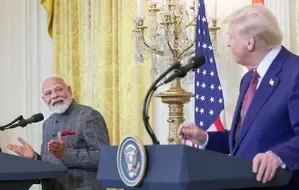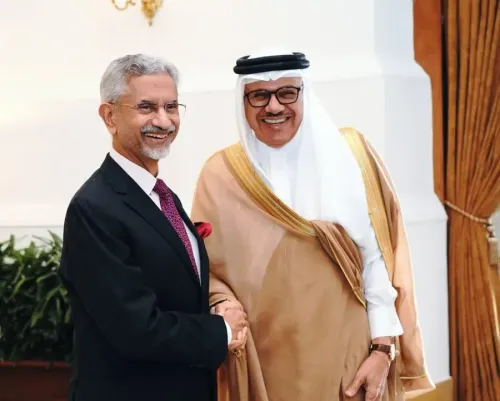Is There a Shift in the Current Crisis Over India-US Trade Tariffs?

Synopsis
Key Takeaways
- Recent US tariffs on Indian goods are seen as a response to India's economic rise.
- Negotiations between India and the US may resume shortly.
- Heavy tariffs could significantly impact India's GDP growth.
- Diplomatic relationships are crucial for resolving trade disputes.
- Restructuring supply chains may be necessary for Indian industries.
New Delhi, Sep 13 (NationPress) The statement made by RSS chief Mohan Bhagwat on Friday regarding the imposition of tariffs on Indian products, citing a fear of a resurgent India, was part of a broader discourse.
A report by SBI Capital Markets titled “Tariffs are Made in the USA, but Resilience is Made in India” identified the aggressive tariff policies of the US as a significant flashpoint aimed at exerting pressure on India’s external economic landscape.
This report suggested that the US's approach was intended to suppress India's overall economic progress.
However, recent signs indicate a potential shift in the environment, with expectations of renewed discussions “very soon,” as reported by informed sources.
Critics have been vocal about the heavy tariffs imposed by the US on Indian goods.
Earlier this week, Xu Feihong, China’s Ambassador to India, condemned the US for “leveraging tariffs as a tool to impose excessive prices,” labeling the 50 percent duty on India as “unjust and illogical.”
Trump’s choice to pause additional sanctions against Russia or further tariff increases on China—while targeting India's energy imports—has sparked considerable debate within the US as well.
The situation intensified when Washington abruptly canceled its negotiating team’s trip to New Delhi for the sixth round of bilateral trade discussions last month, despite adding new levies on Indian goods over allegations surrounding oil imports from Russia.
“These developments regarding the US tariff regime are likely to alter supply chains, especially in sectors where India has strategic importance. The impact of Section 232 tariffs on industries such as copper, steel, aluminium, and automotive has been significant, affecting pricing and competitiveness. India is now becoming more sensitive to external trade challenges, necessitating a reevaluation of its trade strategies and sectoral resilience,” noted KPMG, a prominent member of the “Big Four” accounting firms, this month.
Meanwhile, trade discussions with Beijing by Washington are ongoing—again blaming China for Russian imports—with the introduction of new tariffs postponed twice, now extending until November 10.
Anantha Nageswaran, India’s Chief Economic Advisor, cautioned that the layered tariffs of 25 percent + 25 percent on Indian exports by the Trump administration are explicitly “punitive” and could potentially reduce India’s GDP growth by 0.5–0.6 percentage points, effectively aiming to hinder India’s growth trajectory.
Throughout this time, the US President has refrained from imposing new sanctions on Russia beyond current penalties on oil buyers.
He has maintained that he is “prepared” to take action but is closely coordinating with European allies and fostering peace negotiations, thus delaying any immediate escalation against Moscow.
However, a shift in dynamics may be on the horizon.
President Trump seems to be moderating his stance. His nominee for the upcoming ambassador to India, Sergio Gor, indicated that the US President shares an “incredible relationship” with PM Modi, signaling a possible new direction.
Gor highlighted that President Trump has regularly acknowledged PM Modi positively, even while raising concerns over trade matters.
Washington’s actions appear to be driven by a combination of diplomatic strategy, trade negotiation tactics, and a clear intent to disrupt the Russia-India-China alliance, leaving uncertainty in their wake.
Recent diplomatic developments surrounding this axis, along with conflicting reports regarding the US economy, are being pointed to as potential reasons for the shifting climate.
A federal trade court ruled in May that the President overstepped his authority in imposing tariffs under the International Emergency Economic Powers Act. Last month, the United States Court of Appeals for the Federal Circuit upheld this ruling.
The Supreme Court is set to hear arguments concerning US tariffs, with the outcome likely to affect numerous businesses in the US and exporters from other countries, including India.









